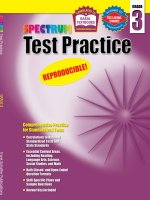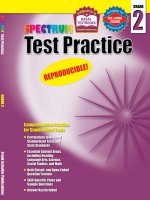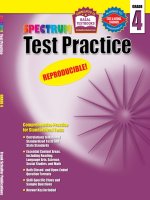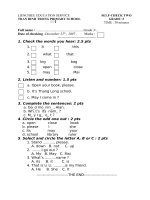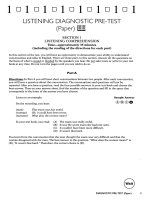Fresh reads for differentiated test practice grade 3 TM 188p
Bạn đang xem bản rút gọn của tài liệu. Xem và tải ngay bản đầy đủ của tài liệu tại đây (2.82 MB, 188 trang )
NOTES TO THE TEACHER
Introduction
Fresh Reads for Differentiated Test Practice is designed to provide
differentiated practice in reading comprehension skills and to prepare students
to take the Reading/Language Arts section of standardized tests, state tests,
or teacher-made tests. The student book includes the weekly differentiated
practice tests to strengthen comprehension skills taught in Scott Foresman
Reading Street. This Teacher’s Manual includes the following: (1) notes on
how to use the Fresh Read tests, (2) instructions on how to administer and
score a fluency test, (3) a chart on which you may record the progress of your
students, and (4) annotated copies of all of the Fresh Read tests indicating the
correct answer to all questions.
How to Use the Fresh Read Tests
The purpose of the Fresh Read tests is to give weekly differentiated practice in
target comprehension skills taught in Scott Foresman Reading Street.
This book contains three Fresh Read tests for each week to be used
independently from the main selection in Scott Foresman Reading Street. The
tests consist of a “Fresh Read” leveled passage and related comprehension
items that focus on the target and review comprehension skills of the week but
are written to address varying levels of proficiency—Strategic Intervention
(SI), On-Level (OL), and Advanced (A). A code at the bottom of each page
tells you the level of each test.
© Pearson Education 3
You can assess students’ proficiency levels using their responses to discussion
questions in class and their work on the comprehension pages in the
Practice Book or Teacher’s Resource Book. Fresh Read tests can be done
independently, or you may choose to work through them with students in small
groups, in order to give support and assess students’ progress.
Fresh Reads
v
Other ways to use the Fresh Read test pages:
• use the Strategic Intervention pages for whole-class practice with the
comprehension skills and/or test-taking skills
• use the Strategic Intervention pages after introducing the target and review
comprehension skills but prior to reading the main selection in the student
anthology of Scott Foresman Reading Street to assess students’ readiness
to read that selection
• use the On-Level pages as an assessment tool to check students’
understanding of the comprehension skills and/or test-taking skills
• use the On-Level pages to check students’ need for further practice,
reteaching, or more challenging materials
• use the Advanced pages as a substitute for the comprehension pages in
the Practice Book or Teacher’s Resource Book for students working above
grade level
© Pearson Education 3
• use any of the pages as preparation for the unit Benchmark Test
vi
Fresh Reads
How to Administer and Score a Fluency Test
A fluency test measures a student’s reading rate, or the number of words
correctly read per minute (wcpm), on grade-level text the student has not seen
before. You may want to use a copy of one of the “On-Level” leveled passages
from the Fresh Read tests for this purpose. Make a photocopy for yourself of
the passage you will give the student. (The pages in this Teacher’s Manual
have a scale of running numbers to make it easier for you to know how many
words the student read during the fluency check, while the passages in the
student edition do not have the numbers.) Make sure you have put the student’s
name and the test date at the top of your copy of the passage. Have a watch or
clock with a second hand available for timing the reading.
Give the student a copy of the passage for the test. Note: The student should
NOT have seen the passage beforehand; it is a “fresh” reading passage for
the student. Do NOT allow the student to read the passage silently before oral
reading.
Have the student read the text aloud. Do not have the student read the title as
part of the fluency reading; it is not included in the running word count. (You
may want to tape-record the student’s reading for later evaluation.) Stop the
student at exactly one minute and note precisely where the student stopped.
As the student reads orally, on your copy of the text mark any miscues or
errors the student makes during the reading (see the chart on page viii). Count
the total number of words the student read in one minute. Subtract any words
the student read incorrectly. Record the words correct per minute score on the
test.
The formula is: Total # of words read – # of errors = words correct per minute
(wcpm).
© Pearson Education 3
You will likely want to keep the test in your folder for the student. You may
also want to record students’ progress on the Reading Fluency Progress Chart
on page xi.
Fresh Reads
vii
How to Identify Reading Miscues/Errors
Using the passage on page ix, the chart below shows the kinds of miscues
and errors to look for as a student reads aloud and the notations to use to
mark them.
Reading Miscue
Notations
Omission
The student omits words or word
parts.
Sanya had to write a report for her
science class about a planet she had
never visited.
Substitution
The student substitutes words or
parts of words for the words in the
text.
Sanya’s mom came into the room.
Insertion
The student inserts words or parts of
words that are not in the text.
Sanya was tiredaround
of looking at her
screen and turned to look out the
window.
Mispronunciation/Misreading
The student pronounces or reads a
word incorrectly.
I can’t think of a better way to learn
place
about a planet.
Hesitation
The student hesitates over a word
and the teacher provides the word.
It was raining on Planet Octor.
Self-correction
The student reads a word incorrectly
but then corrects the error.
Mom agreed, so they jumped into
their spaceship and headed for Earth.
her
H
sc
Notes
• If the student hesitates over a word, wait several seconds before telling the
student what the word is.
• Self-correction is not counted as an actual error. However, writing “SC”
over the word or words will help you identify words that give the student
some difficulty.
viii
Fresh Reads
© Pearson Education 3
• If a student makes the same error more than once, count it as only one
error.
Sample Fluency Test
Here is the passage marked as shown on the previous page. This is the “OnLevel” passage from Grade 3, Unit 1, Week 1. As the student reads the passage
aloud to you, mark miscues and errors. Have the student read for exactly one
minute, and then mark the last word the student reads.
Name
9/4/2009 92
Susan
Boom Town
Sanya’s Science Report
around
Sanya was tired of looking at her screen and turned to look out the window. It
H
16
was raining on Planet Octor. Sanya had to write a report for science class about a
32
planet she had never visited.
37
her
Sanya’s mom came into the room. “Why aren’t you reading your teaching
screen?” she asked.
49
52
“Oh, I have been. I’ve decided to write about Earth,” Sanya said. “Why don’t we
place
go there? I can’t think of a better way to learn about a planet.”
67
81
sc
Mom agreed, so they jumped into their spaceship and headed for Earth. Sanya
94
looked out the window as they traveled. She recognized Norbeed, a red planet she
108
and her family had visited on vacation. It still had a red halo around it.
123
© Pearson Education 3
97 - 5 = 92
Total number of words read 97
number of errors
– 5
Words correct per minute
Fresh Reads
92
ix
Interpreting the Results
According to published norms for oral reading fluency, students at the end of
Grade 3 should be reading fluently at 120 words correct per minute in text that
is on grade level. This chart gives recommended progress toward that goal.
End of Unit/Grade
Reading Rate (wcpm)
Grade 3
Unit 1
80 to 90
Grade 3
Unit 2
85 to 95
Grade 3
Unit 3
90 to 100
Grade 3
Unit 4
95 to 105
Grade 3
Unit 5
102 to 112
Grade 3
Unit 6
110 to 120
End of Year Goal
120
© Pearson Education 3
If a student’s reading rate is lower than the suggested progress toward the
standard for his or her grade level, your notes on the student’s miscues may
help you determine why the rate is low. Does the student make errors that
indicate his or her decoding skills are poor? If so, further instruction in phonics
may be needed. Do the errors reflect a lack of comprehension or limited
vocabulary? In that case, instruction in comprehension strategies and exposure
to more vocabulary words may help. A lack of fluency may indicate a lack of
exposure to models of fluent oral reading. It may also mean that the student
isn’t reading enough material at his or her reading level. “Matching Students to
Texts” in the Additional Resources section at the back of the Scott Foresman
Reading Street Teacher’s Editions gives suggestions on increasing reading
fluency.
x
Fresh Reads
Reading Fluency Progress Chart
Unit 1
Student’s Name
Date
WCPM
Unit 2
Date
WCPM
Unit 3
Date
WCPM
Unit 4
Date
WCPM
Unit 5
Date
WCPM
Unit 6
Date
WCPM
1.
2.
3.
4.
5.
6.
7.
8.
9.
10.
11.
12.
13.
14.
15.
16.
17.
18.
19.
20.
21.
22.
23.
24.
25.
© Pearson Education 3
26.
27.
28.
29.
30.
31.
32.
33.
34.
35.
Fresh Reads
xi
Boom Town
Name
Read the selection. Then answer the questions that follow.
Lucky Lucy
Lucy Mouse was excited. Today a new mouse was coming to class.
12
“Meet our new student, Ted Mouse,” said Mr. Toad. “Let’s make him feel
25
welcome.”
26
No one said a word. They were all staring because Ted had no tail!
40
At lunch, no one invited Ted to join them. Lucy felt sorry for Ted, but she was
57
going to sit with her friends. Then she slipped and dropped all her food. No one
73
said a word. They all just stared at her.
82
Only Ted walked over to Lucy. He said, “Don’t worry. I’ll help you.”
108
© Pearson Education 3
Ted helped Lucy get more food. Then Ted and Lucy ate lunch together.
95
Turn the page.
Fresh Reads
Unit 1 Week 1 SI
1
Answer the questions below.
1
You know this story is a fantasy because the animals
⅜ stare.
⅜ eat.
⅜ walk.
⅜ talk.
2
Ted Mouse probably helped Lucy because he is
⅜ scared.
⅜ angry.
⅜ kind.
⅜ famous.
3
How is this fantasy most like a realistic story?
⅜
⅜
⅜
⅜
4
Two mice talk to each other.
Two students help each other.
The new student is a mouse.
The teacher is a toad.
What is the first clue that this story is a fantasy?
© Pearson Education 3
The first clue is that Lucy Mouse is excited.
2
Fresh Reads
Unit 1 Week 1 SI
Boom Town
Name
Read the selection. Then answer the questions that follow.
Sanya’s Science Report
Sanya was tired of looking at her screen and turned to look out the window. It
was raining on Planet Octor. Sanya had to write a report for science class about a
32
planet she had never visited.
37
Sanya’s mom came into the room. “Why aren’t you reading your teaching
screen?” she asked.
“Oh, I have been. I’ve decided to write about Earth,” Sanya said. “Why don’t we
go there? I can’t think of a better way to learn about a planet.”
49
52
67
81
Mom agreed, so they jumped into their spaceship and headed for Earth. Sanya
94
looked out the window as they traveled. She recognized Norbeed, a red planet she
108
and her family had visited on vacation. It still had a red halo around it.
123
Sanya knew from her teaching screen that Earth was different from Octor and
136
Norbeed. Earth was a planet of blue water and green land. After three days, the blue
152
and green planet came into view. Just as the spaceship was coming into landing
166
orbit, Sanya heard a loud noise.
172
“Don’t worry,” Mom said. “That’s just a signal from the Earth crew letting us
know they’re ready to pull us in.”
© Pearson Education 3
16
Sanya smiled. She was eager to learn about Planet Earth.
186
193
203
Turn the page.
Fresh Reads
Unit 1 Week 1 OL
3
Answer the questions below.
1
How was Sanya’s mother like a real mom?
⅜ She wanted to help her daughter.
⅜ She knew how to fly a spaceship.
⅜ She visited Norbeed.
⅜ She lived on Octor.
2
What makes this story a fantasy?
⅜ It is about people making a long trip.
⅜ It gives facts about space travel.
⅜ It asks a question and gives more than one answer.
⅜ It is about something that could not happen.
3
How did Sanya feel at the end of the story?
⅜
⅜
⅜
⅜
proud
eager
worried
afraid
4
Which event in this story tells you it is a fantasy?
⅜ A girl had to write a science report.
⅜ A girl traveled to another planet.
⅜ A girl learned about another planet.
⅜ A family took a vacation.
5
What is the first clue that this story is a fantasy?
© Pearson Education 3
It was raining on Planet Octor.
4
Fresh Reads
Unit 1 Week 1 OL
Boom Town
Name
Read the selection. Then answer the questions that follow.
The Fire Stealer
Once upon a time, there was no fire on the Earth, and animals everywhere were
freezing. They could see the fire in the sun but could not get even a tiny coal
32
from fierce Firekeeper, the sun’s guardian. One day the animals were so cold they
46
decided to take some fire.
51
Brave Crow said, “I will fly to the sun and take a piece of coal. Firekeeper
will not miss such a tiny piece.”
But Firekeeper noticed him and was so furious that he burned the feathers off of
Crow’s head as punishment.
Then Wily Possum said, “Maybe I can take some fire and hide it in my tail.
Firekeeper will not notice a small coal hidden in my bushy tail.”
But Possum could not fool Firekeeper, and angry Firekeeper burned the fur off
Possum’s tail as punishment.
67
74
89
93
109
121
134
138
Finally, tiny Water Spider said, “I will get so wet that the sun cannot burn me,
154
and I will spin thread to make a little bowl on my back where I can carry the small
173
piece of fire that I take.”
179
Water Spider was so small she could easily slip by Firekeeper. When the animals
© Pearson Education 3
15
saw her carrying back the fire, they all cheered.
Bear said, “You are the smallest in our animal family, yet you gave us this
precious gift of fire.”
193
202
217
221
Turn the page.
Fresh Reads
Unit 1 Week 1 A
5
Answer the questions below.
1
Based on Water Spider’s actions, you can say that she was
⅜ small and afraid.
⅜ smart and brave.
⅜ big and strong.
⅜ sad and lonely.
2
You can tell this story is a fantasy because
⅜ there are no people in the story.
⅜ a problem is solved.
⅜ animals talk.
⅜ it takes place in the past.
3
How was Water Spider like a real person?
⅜
⅜
⅜
⅜
4
The sun could not burn her.
She was so small she could hardly be seen.
She talked with her animal friends.
She made a plan to do something.
How do you know that Firekeeper is not a real person?
5
© Pearson Education 3
In real life, there is not a person who guards the sun.
What part of this story could really happen?
Animals could be cold.
6
Fresh Reads
Unit 1 Week 1 A
What About Me?
Name
Read the selection. Then answer the questions that follow.
First Place
Gene woke up nervous. The music contest was on Monday. Gene was scared.
13
“I can’t do it,” Gene said to his parents.
22
“First you need to practice. I will help you,” Gene’s dad said. They practiced the
37
piano together every day.
Then Gene and his dad went to the contest. Gene heard the other students play.
They played very well. I don’t have a chance, Gene thought to himself.
Later it was Gene’s turn. He looked at his dad and felt better. Gene played
41
56
69
84
without any mistakes. He could not believe it when he heard his name called as the
100
first-place winner.
102
107
© Pearson Education 3
Finally, Gene wasn’t nervous anymore.
Turn the page.
Fresh Reads
Unit 1 Week 2 SI
7
Answer the questions below.
1
The author probably wrote “First Place” to
⅜ tell a story about a boy who wins a contest.
⅜ persuade people to enter a music contest.
⅜ warn people to be patient.
⅜ teach people about music.
2
What was the last thing that happened in this story?
⅜ Gene and his dad practiced piano.
⅜ Gene heard his name called.
⅜ Gene wasn’t nervous anymore.
⅜ It was Gene’s turn to play.
3
What did Gene probably do just after he played the piano in the contest?
⅜
⅜
⅜
⅜
4
took another turn
called his dad
went back to his seat
went home
What do you think Gene and his dad most likely did after the contest?
© Pearson Education 3
Answers may vary. Possible response: Gene and his dad had ice
cream to celebrate.
8
Fresh Reads
Unit 1 Week 2 SI
What About Me?
Name
Read the selection. Then answer the questions that follow.
The Backyard Party
Angie and Gina wanted to have a party because school was almost over for the
15
summer. They wanted to invite all their friends, but their houses were too small for
30
so many people. Gina thought that her big backyard would be perfect for the party,
45
so she asked her mom if she could have the party there. Gina’s mom agreed, so the
62
girls began to make plans for the best party ever.
72
First, Angie and Gina made a list of their friends. Then they made fancy
86
invitations that told the time and place of the party. Next, Angie began writing
100
names on the cards, while Gina made a list of food to buy. Because the weather was
117
warm, Gina wanted to have ice cream for dessert.
126
“What games should we play?” Angie asked.
133
“Let’s play the ring-toss game that we played last summer,” Gina said.
145
Just then Gina’s mom came into the room. “What’s the date of the party?” she
160
161
asked.
Gina and Angie looked at each other and laughed. They had been so busy making
189
© Pearson Education 3
plans for the party that they’d forgotten to pick a day for it!
176
Turn the page.
Fresh Reads
Unit 1 Week 2 OL
9
Answer the questions below.
1
What do you think Gina and Angie will do next?
⅜ plan a beginning of the school year party
⅜ pick a day for the party
⅜ give Gina’s mom a list of food to buy
⅜ practice the ring-toss game
2
What clue words tell you the sequence of events in the second paragraph?
⅜ made, began
⅜ first, then, next
⅜ told, because
⅜ time, place
3
The author probably wrote this story to
persuade the reader to have a party.
express a point of view.
entertain the reader.
give facts about summer.
4
Which of the following happened first?
⅜ Gina got permission to have the party.
⅜ Angie and Gina made invitations.
⅜ Gina’s mom asked about the date of the party.
⅜ Gina and Angie made a list of friends to invite.
5
If you were planning a party, what would you do first, second, and third?
Answers may vary. Possible response: First, I would decide
when to have the party. Second, I would decide whom to
invite. Third, I would decide what food to serve.
10
Fresh Reads
Unit 1 Week 2 OL
© Pearson Education 3
⅜
⅜
⅜
⅜
What About Me?
Name
Read the selection. Then answer the questions that follow.
Henry’s New Bed
My cat Henry could sleep almost anywhere and anytime. Sometimes I found him
13
curled up in an armchair, or sleeping on a pile of clothes, or napping in my bed.
30
One day my mom told me that it was time for Henry to have a bed of his own.
49
“Carl, you should make a bed for Henry,” Mom said. “I’ll help you.”
62
First, we looked for a basket in the basement and found an old laundry basket
77
that we didn’t use anymore. Next, we needed something soft for Henry to sleep on.
92
I suggested my pillow, but Mom didn’t think that was a good idea. She found some
108
old towels and put them in the basket. I wanted to show the bed to Henry right
125
away, but Mom said that we should put one of his favorite toys in the basket first. I
143
found Henry’s toy mouse and put it in the basket.
153
“Now we need to find a place to put Henry’s bed,” Mom said.
166
We decided to put Henry’s bed on the floor near my bed. When I showed Henry
182
198
asleep. From then on, we found him in his own bed more often than in mine.
214
© Pearson Education 3
his new bed, he jumped right in, turned around a few times, and then quickly fell
Turn the page.
Fresh Reads
Unit 1 Week 2 A
11
Answer the questions below.
1
What happened right after Mom and Carl found the basket for Henry?
⅜ Henry jumped into the basket.
⅜ Carl found Henry’s toy.
⅜ Carl found a place for the basket.
⅜ Mom found some towels.
2
The author probably wrote this story to
⅜ describe a funny cat.
⅜ explain how to make a cat bed.
⅜ persuade the reader to buy a cat.
⅜ frighten the reader.
3
Henry saw his new bed for the first time right after Mom and Carl
⅜
⅜
⅜
⅜
4
put the towels in the basket.
found a basket.
looked for a basket.
found a place for the bed.
Why was it important to put one of Henry’s favorite toys in the basket before showing him
his new bed?
5
© Pearson Education 3
Answers may vary. Possible response: It was important so
that the new bed would not seem so strange.
What are the clue words that tell you the sequence of events in this story?
one day, first, next, now, from then on
12
Fresh Reads
Unit 1 Week 2 A
Alexander
Name
Read the selection. Then answer the questions that follow.
Makoto’s Garden
Every day after school Makoto helped her grandmother in the garden. One day
Makoto asked her grandmother if she could have a plant of her own.
13
26
Grandmother smiled and said, “First, get a pot and fill it with dirt from the shed.”
42
Makoto came back with a pot filled with dirt. “What’s next?” she asked.
55
Grandmother showed Makoto some packages of seeds.
62
“What do you want to grow?” she asked.
70
Makoto chose the tomato seeds. Then her grandmother showed her how to bury
83
the seeds in the dirt and gently water them.
102
© Pearson Education 3
“Now the pot needs to get some sun,” said Grandmother.
92
Turn the page.
Fresh Reads
Unit 1 Week 3 SI
13
Answer the questions below.
1
When did Makoto plant her seeds?
⅜ after she watered them
⅜ after she put the dirt in the pot
⅜ after she put the pot in the sun
⅜ before she got the dirt from the shed
2
How can you tell that Makoto liked gardening?
⅜ She liked tomatoes.
⅜ She knew how to plant seeds.
⅜ She asked for her own plant.
⅜ She played outside after school.
3
If the pot of seeds gets enough sun and water, what will happen next?
⅜
⅜
⅜
⅜
4
It will be time for school.
Grandmother will be angry at Makoto.
Tomato plants will start to grow.
Makoto will fill the pot with dirt.
What will Makoto and her grandmother probably do next with the pot?
© Pearson Education 3
They will put it in the sun.
14
Fresh Reads
Unit 1 Week 3 SI
Alexander
Name
Read the selection. Then answer the questions that follow.
Hot Dog Wraps
Here is a treat for your whole family. You will need some help to make them.
16
You will need:
butter
4 slices of bread
4 slices of cheese
4 hot dogs
19
20
24
28
31
Spread butter on each slice of bread. Spread it on one side only. Then put the
47
bread on a baking sheet with the butter side down. Put one slice of cheese on each
64
slice of bread. Put one hot dog across each slice of cheese. Place the hot dog from
81
one top corner to the opposite bottom corner of the bread.
92
Then ask a grown-up to help you turn on the oven to 375°.
105
Next, for each slice of bread, fold the two other corners over the hot dog. Push
121
two toothpicks through the bread and into the hot dog to hold them together. This is
137
what makes the wrap.
141
Ask for help putting the baking sheet into the oven. Bake for about 10 minutes.
156
The bottoms of the bread should be a light brown. Ask for help again to take the
173
baking sheet out of the oven. Use a spatula to put the hot dog wraps on plates.
190
Eat up!
© Pearson Education 3
192
Turn the page.
Fresh Reads
Unit 1 Week 3 OL
15
Answer the questions below.
1
What do you do right after you put the hot dog on the bread?
⅜ Wait for ten minutes.
⅜ Put the cheese on the bread.
⅜ Put butter on one side of the bread.
⅜ Get help turning on the oven.
2
What is happening while you are wrapping up the hot dogs?
⅜ The hot dogs are cooking.
⅜ The oven is heating.
⅜ The cheese is melting.
⅜ The bread is turning brown.
3
Why do you use a spatula to take the wraps off the baking sheet?
to keep the hot dogs from falling off
so that you will not burn your fingers
so that you will not need help
to make sure they are done on top
4
What would you do before you started making Hot Dog Wraps?
⅜ Turn on the oven to 375°.
⅜ Butter the bread and cook the hot dogs.
⅜ Make sure a grown-up was around to help.
⅜ Tell your family that dinner was ready.
5
Why must you butter the bread first?
Answers may vary. Possible response: because you can’t
butter the bread when the cheese and hot dogs are on it
16
Fresh Reads
Unit 1 Week 3 OL
© Pearson Education 3
⅜
⅜
⅜
⅜
Alexander
Name
Read the selection. Then answer the questions that follow.
Basketball Practice
Benny and Derrick walked to the gym together for basketball practice as they
13
did every Saturday morning. There they found a note from Coach Saba taped to the
28
door. The note said that the coach had been called away and that practice would
43
begin one hour late.
47
Benny and Derrick did not want to walk all the way back home, so they walked
63
to the bookstore instead. When they got there, the store was closed. They started
77
walking back to the gym, but on the way they met Rafael. The three friends decided
93
to walk to the park.
98
After walking through the park, the boys headed back toward the gym. On the
112
way, they met Erica who was going to the library. The four friends walked to the
128
library together.
130
When Benny and Derrick finally got back to the gym, Coach Saba was waiting
for them.
144
146
159
“Oh, no,” said Benny. “I feel as if I already ran around the gym at least twice.”
176
And the two friends began to laugh.
183
© Pearson Education 3
“OK, we’re going to warm up by running around the gym,” he said.
Turn the page.
Fresh Reads
Unit 1 Week 3 A
17


